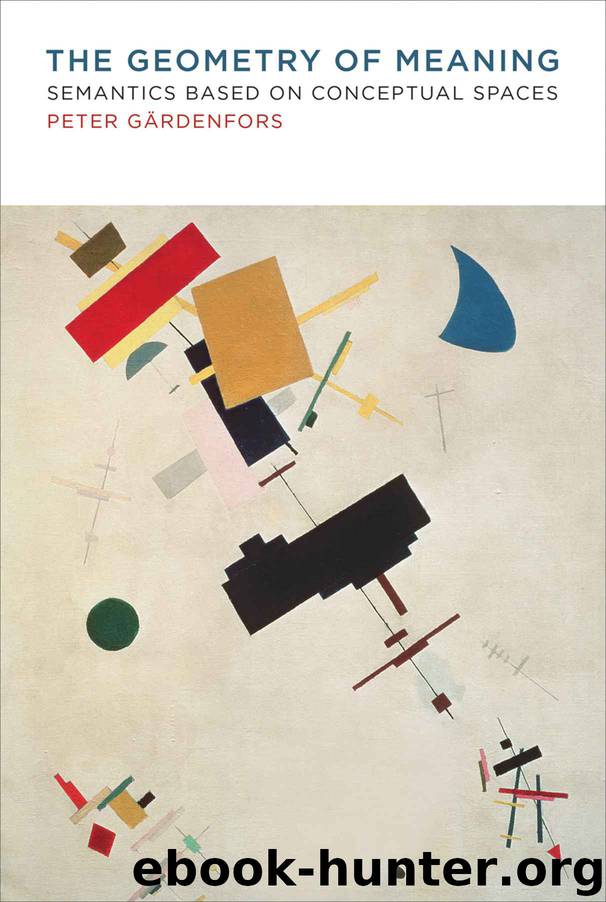The Geometry of Meaning: Semantics Based on Conceptual Spaces by Peter Gärdenfors

Author:Peter Gärdenfors [Gärdenfors, Peter]
Language: eng
Format: epub
ISBN: 9780262319591
Publisher: The MIT Press
Published: 2014-01-17T00:00:00+00:00
Figure 9.3
Changes represented as vectors in patient space P.
I now have the tools to define an event category: an event category is a structure that represents how the agent space affects the patient vector field. Thus an event category should represent not only the mapping from one action to the patient vector field but also the way all actions in the action category of the agent space affect the patient. For example, an event category of pushing a table should be able to represent the effect of different, albeit similar, patterns of force on the different points in the table patient space.
The model allows me to represent events at different levels of generality. There are subcategories of events just as there are for object categories. For example, pushing a door open is a subcategory of pushing a door, where the force vector exceeds the counterforce of the patient. Pushing a door but failing to open it is another subcategory, where the counterforce annihilates the force vector.
Can events be represented as convex regions of some suitable space, in the same sense as I have argued for properties, concepts, and actions? At present, I do not have a general answer to this question. A simple mathematical model of an event category is as a region of the space consisting of the product of action space A and the vector field of changes P × P.16 Although actions are convex regions of A, and properties are convex regions of P, this does not guarantee that events will be convex regions of A × P × P. The conditions under which this will hold remain to be determined.
The models of actions and events that I have presented in this book are motivated by using conceptual spaces as a framework. What is new—apart from using conceptual spaces—in this model of events and event categories is the introduction of the two vectors associated with force and result. A corresponding model for processes can be developed, but I will not pursue that topic here.
9.5 Three Conceptualizations of Events in Linguistics
My approach has clear connections to the way linguists have conceptualized events to understand verb semantics. Among linguistic approaches, three have gained prominence (Levin & Rappaport Hovav, 2005, chap. 4): the localist, the aspectual, and the causal. The localist approach focuses on motion and location, in physical as well as in abstract spaces. The aspectual approach puts the temporal properties of events in the center. The causal approach highlights the role of causal chains and transmissions of force. These three approaches have been connected with the role of verbs. I want to show that all three approaches can be subsumed under the general model of events presented in this chapter. The proposed model brings out the strengths and limitations of the approaches while providing a unifying common ground for their central features.
9.5.1 Localist Approach
Jackendoff’s (1976, 1983, 1990) localist hypothesis claims that all verbs are construable as verbs of motion and location (Levin & Rappaport Hovav, 2005, p.
Download
This site does not store any files on its server. We only index and link to content provided by other sites. Please contact the content providers to delete copyright contents if any and email us, we'll remove relevant links or contents immediately.
The Art of Thinking Clearly by Rolf Dobelli(10172)
Mindhunter: Inside the FBI's Elite Serial Crime Unit by John E. Douglas & Mark Olshaker(9153)
Change Your Questions, Change Your Life by Marilee Adams(7606)
Nudge - Improving Decisions about Health, Wealth, and Happiness by Thaler Sunstein(7529)
Mastermind: How to Think Like Sherlock Holmes by Maria Konnikova(7194)
The Power of Now: A Guide to Spiritual Enlightenment by Eckhart Tolle(5577)
Men In Love by Nancy Friday(5136)
Altered Sensations by David Pantalony(5027)
Factfulness: Ten Reasons We're Wrong About the World – and Why Things Are Better Than You Think by Hans Rosling(4670)
The Confidence Code by Katty Kay(4172)
Thinking in Bets by Annie Duke(4139)
Man and His Symbols by Carl Gustav Jung(4051)
The Worm at the Core by Sheldon Solomon(3417)
Why Buddhism is True by Robert Wright(3387)
Liar's Poker by Michael Lewis(3350)
Three Women by Lisa Taddeo(3340)
The Inner Life of Animals by Peter Wohlleben(3241)
Descartes' Error by Antonio Damasio(3208)
The Power of Mindful Learning by Ellen J. Langer(3169)
